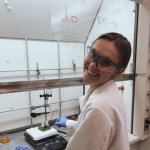
Support
My research this summer studied a portion of the morphine molecule using the Wagner-Jauregg reaction. The final goal of this research is to use the Wagner-Jauregg reaction to synthesize a morphine-like molecule, that could have reduced addictive properties and allow people to use morphine without the risk of addiction. The Wagner-Jauregg reaction involves a double Diels-Alder reaction between a diene and dienophile. This reaction allows us to use cheaper and readily available molecules to synthesize more complex molecules, such as morphine. By using the same basic core molecule and modifying small groups of atoms, we can make a library of morphine derivates and potentially replacements.
Originally, I was going to focus on intercepting the intermediate after the first Diels-Alder reaction. My first approach was to synthesize a diene to use in the reaction but when I reacted this diene with two different dienophiles, it gave no useful product at all. Something that I learned was if I use the solvent aniline in the reaction, it will consume the dienophiles instead catalyzing the reaction. From this, I learned how different solvents can impact a reaction. I decided to move on from this diene and revisit a diene and dienophile that we already knew worked well in this reaction. I used this reaction to explore the properties of the Wagner-Jauregg reaction. I learned that water is a good solvent because it pushed the hydrophobic diene and dienophile together, making the reaction cheaper and more environmentally friendly. After purifying and analyzing this reaction, I isolated the “ene” product, which the Tartakoff research group had not explored, and I decided I wanted to learn more about the “ene” product instead of my original target.
I synthesized two new dienes through a Wittig reaction. These dienes had different properties than the previous one. I wanted to explore how different functional groups coming off the diene impacted the rate of the reaction. I reacted these dienes with a dienophile using water as the new solvent. After testing this reaction at different temperatures, I discovered that adding a functional group to a certain position of the diene helped increase the reaction rate but adding the same functional group to another position slowed down the reaction. I also used a variety of different techniques to isolate the “ene” product from the side-products formed in the crude reaction mixture.
In the future, I want to continue this research for my Senior Year Experience. I want to use what I learned and find the right conditions, diene, and dienophile to synthesize morphine and send it out for testing. This summer I gained confidence in laboratory techniques, and learned I want research to be a part of my life after college. I am thankful for this experience.

